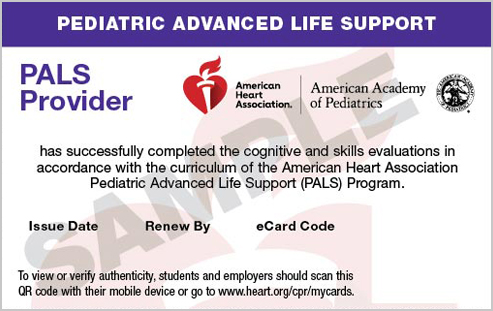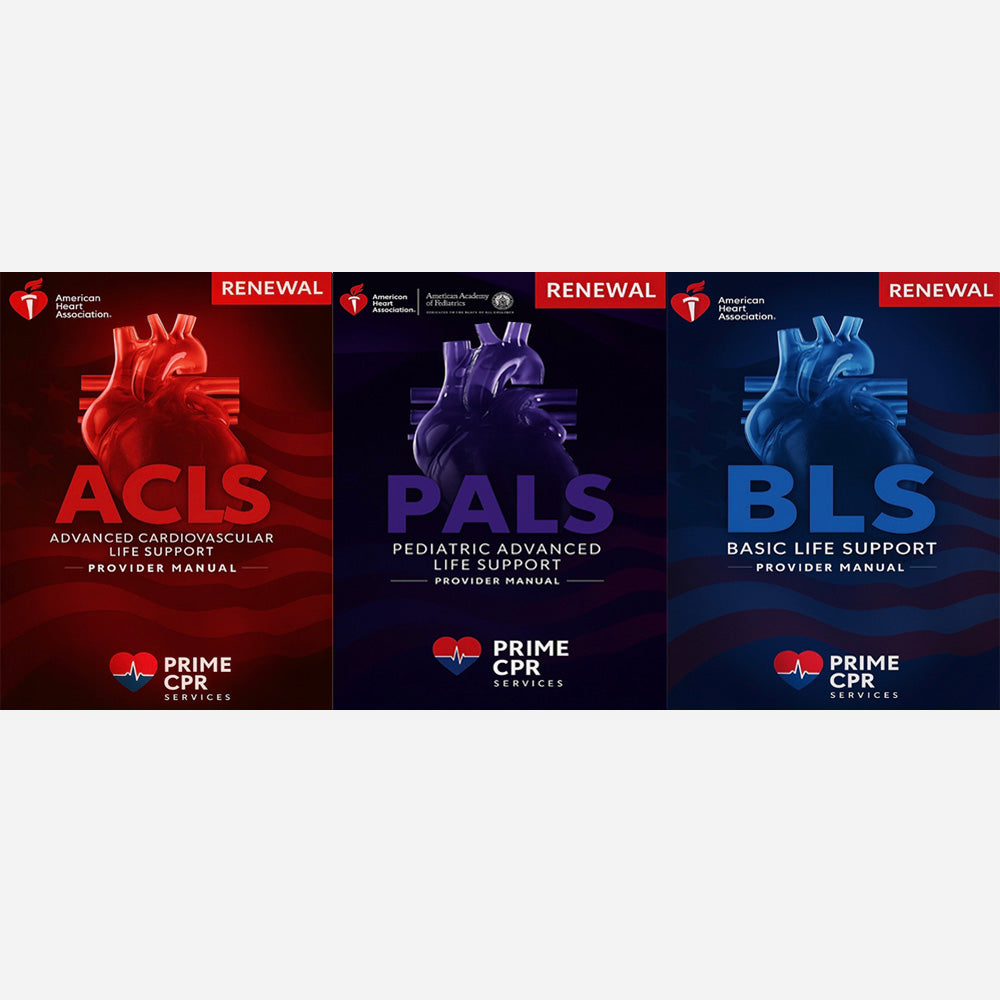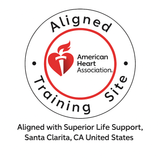Understanding ACLS Renewal and Its Importance
Prime CPR Services offers the American Heart Association ACLS RENEWAL, PALS RENEAL with BLS FOR HEALTHCARE PROVIDERS RENEWAL efficiently and conveniently with our one-day package! Our experienced American Heart Association instructors will review the latest life-saving techniques and skills approved by AHA standards. This trifecta of training is ideal for fulfilling your medical profession's requirements in just one day. You will get all 3 AHA cards right after the class.



If you need a book, we ship priority, so you receive them well in advance of your scheduled class. You may also consider alternative book options by getting an ACLS ebook by clicking HERE, PALS ebook by clicking HERE and/or the BLS ebook by clicking HERE.
ACLS RENEWAL covers the core principles, including:
- BLS Review: Basic Life Support (BLS). 1 and 2 Rescuer High-quality CPR for adults, children, and infants, use of a Bag Valve Mask (BVM), use of an Automated External Defibrillator (AED), and relief of choking.
- Systematic Approach: Assessment, Identification of rhythms, and appropriate interventions. Effective team dynamics, Roles and Responsibilities during a resuscitation, Management of a patient in cardiac arrest or other cardiovascular emergencies.
- Rhythm Recognition and Scenarios: Ventricular Fibrillation (VF) and Pulseless Ventricular Tachycardia (VT), as well as non-shockable rhythms like Asystole and Pulseless Electrical Activity (PEA). Sinus Bradycardia and Supraventricular Tachycardia (SVT)
- Electrical Therapy: Defibrillation, Cardioversion, and Pacing.
- Pharmacology: Indications, Dosages, and Administration routes of Atropine, Amiodarone, Adenosine, Epinephrine, and Dopamine.
- Post-Cardiac Arrest Care: Critical care following Return of Spontaneous Circulation (ROSC), including targeted temperature management and other post-cardiac arrest interventions.
PALS RENEWAL covers the core principles, including:
- Pediatric Assessment: Systematically assess pediatric patients, identify potential life-threatening conditions, and prioritize interventions based on the child's condition.
- Basic Life Support (BLS) Skills: The course covers high-quality CPR (Cardiopulmonary Resuscitation) for infants, children, and adults, including chest compressions, rescue breaths, and the use of an Automated External Defibrillator (AED).
- Pediatric Algorithms: Participants are taught PALS-specific algorithms and flowcharts for managing various pediatric emergencies, such as respiratory distress, respiratory failure, bradycardia, tachycardia, and cardiac arrest.
- Respiratory Emergencies: The class covers the recognition and management of respiratory distress, respiratory failure, and respiratory arrest in pediatric patients.
- Cardiac Arrest Management: Participants learn the steps to manage cardiac arrest in infants and children, including the use of appropriate medications, defibrillation, and advanced airway management.
- Vascular Access: Techniques for obtaining vascular access in pediatric patients are taught, including intraosseous (IO) access and peripheral intravenous (IV) access.
- Pharmacology: The course covers the indications, dosages, and administration of medications used during pediatric resuscitation, such as epinephrine, amiodarone, and atropine.
- Bradycardia and Tachycardia Management: Participants learn to identify and manage various heart rhythms associated with bradycardia and tachycardia in pediatric patients.
- Post-Cardiac Arrest Care: The class covers critical care following successful resuscitation, including post-cardiac arrest interventions and targeted temperature management.
- Team Dynamics: Effective communication and teamwork during pediatric emergencies are emphasized to ensure efficient and coordinated care.
BLS RENEWAL covers the following:
- AHA’s Chain of Survival for Improved Survival from Cardiac Arrest in Adults, Children, and Infants
- Assessment: Adult, Children and Infants Prior to CPR
- CPR: High-Quality 1 and 2 Rescuer CPR and AED for Adults, Children, and Infants
- Ventilation: Barrier Device, Bag Valve Mask (BVM) and Advanced Airway in Place
- Team Dynamics: Importance of Teams in Multi-Rescuer Resuscitation and Performance.
- Choking: Relief of Foreign-Body Airway Obstruction (Choking) for Adults, Children, and Infants
- Narcan: The Use of Narcan for Opiate Overdoses
Free to call, text or email us if you have any questions or concerns.
What is ACLS Renewal?
ACLS renewal, which stands for Advanced Cardiovascular Life Support renewal, is crucial for healthcare professionals. It ensures that they stay updated on the latest guidelines and techniques in cardiac emergency care. Renewing your ACLS certification is essential because it reinforces your skills and knowledge, allowing you to provide the best possible care in critical situations. Emphasis is placed on both the theoretical concepts and practical skills necessary for effective patient management during cardiac and respiratory emergencies.
Why You Should Consider PALS and BLS Renewals
While ACLS renewal is vital, equally important are Pediatric Advanced Life Support (PALS) and Basic Life Support (BLS) renewals. PALS focuses on the unique aspects of resuscitating pediatric patients, while BLS covers fundamental life-saving skills applicable to patients of all ages. By enrolling in these renewal courses, healthcare providers can improve their emergency response abilities, ultimately leading to better patient outcomes. Because a wide range of scenarios can arise unexpectedly, comprehensive training ensures preparedness.
The Benefits of Staying Certified
Being current with ACLS, PALS, and BLS renewals can significantly impact your career as a healthcare provider. Certifications open up new job opportunities and enhance your credibility within the medical community. Moreover, many employers require up-to-date certification for critical care positions, positioning certified professionals as more competitive candidates. Therefore, investing time in these renewals is not just about compliance but also about personal growth and increased responsibility in patient care settings.



